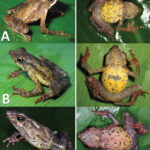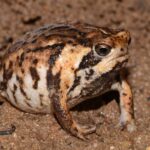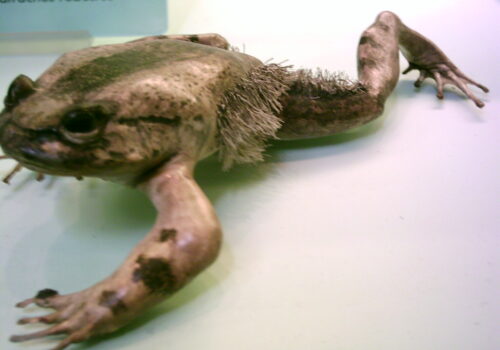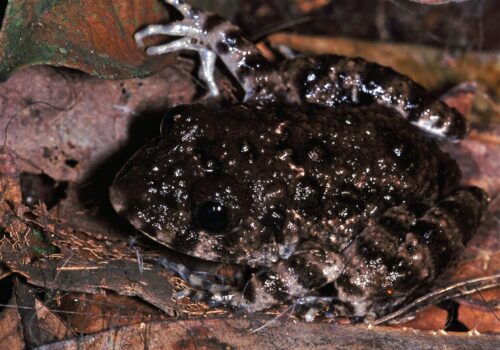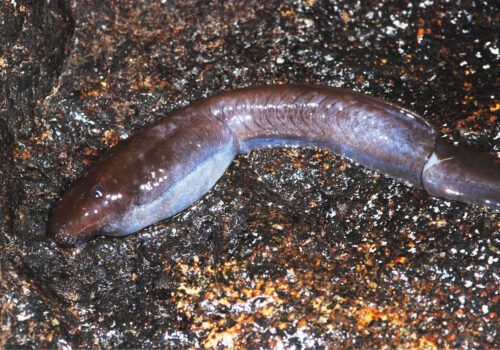Leptodactylodon polyacanthus: Unveiling the Hidden Wonders of Cameroon’s Thorny Forest Frog#
Beneath the thick, verdant canopy of Cameroon’s humid, tropical forests, a small and enigmatic frog goes mostly unnoticed, subtly blending into its damp surroundings. Leptodactylodon polyacanthus, affectionately known as the Thorny Forest Frog, embodies the mysteries and marvels hidden within the heart of Africa’s dwindling rainforests. As a subtle guardian of pristine forest streams, this elusive amphibian serves as a biological compass, guiding scientists through the complexity and fragility of an ecosystem that is increasingly under threat.
While this curious amphibian might not possess the flamboyant coloration or striking calls of more famous rainforest counterparts, subtlety is its greatest strength. Adorned with minuscule, spine-like tubercles covering its skin, hence the name “polyacanthus,” this species encapsulates a rich evolutionary story. Though often overlooked, this frog’s survival and ecological role hold crucial implications for both biodiversity and conservation advocates worldwide.
Taxonomy and Classification#
Scientifically classified as Leptodactylodon polyacanthus, this intriguing species belongs squarely in the Arthroleptidae family—a diverse and ecologically significant group of amphibians endemic to Sub-Saharan Africa. Within the genus Leptodactylodon, famed for terrestrial, litter-dwelling, and stream-associated adaptations, the Thorny Forest Frog is recognized as distinct by unique morphological features.
This family, Arthroleptidae, boasts widely diverse representatives that range from diminutive forest floor inhabitants to more robust species dwelling within intricate stream-side microhabitats. The genus name Leptodactylodon itself originates from Greek roots, “lepto” meaning “slender”, and “dactylos” meaning “finger”, referencing the delicate limb structures that enable agile navigation through moist leaf-litter and rocky substrates.
First described scientifically in 1971 by celebrated herpetologist Jean-Louis Amiet, L. polyacanthus stands apart from allied species such as L. albiventris through distinct morphological characteristics primarily associated with its highly textured, thorn-covered skin and comparatively robust body structure. This seemingly tiny detail has led researchers down pathways of unanswered questions regarding evolutionary pressures influencing its fascinating adaptation.
Natural Habitat#
Leptodactylodon polyacanthus calls one primary region home: the verdant highland forests of western Cameroon, located along the Cameroonian volcanic line. The moisture-laden forests of Mount Nlonako, Mount Manengouba, and Mount Kupe, seeped in fog and mist, provide a sanctuary that perfectly caters to the delicate environmental preferences of this amphibian.
Stream and Forest Floor Dweller#
Venturing beneath the jungle canopy reveals an intricate network of small streams and rivers, shaded by a dense tapestry of broad-leaved trees cloaked in lichens, mosses, and epiphytes. It is in these carefully balanced microhabitats, intensely humid and shielded from direct sunlight, where the Thorny Forest Frog thrives.
Foraging cautiously among damp leaf litter or crouching inconspicuously amongst mossy rocks, the frog displays a fascinating adaptation to an amphibious existence nourished by pristine waters. Surrounded by nutrient-rich soils and freshwater courses, the habitat features optimal microclimates supporting its sensitive skin condition, vital for respiration and moisture regulation.
Through their intimate dependence on clear-flowing mountain streamlets and adequately preserved forest canopies, these frogs also function as sensitive biological barometers, instantly reflecting even minor ecological disturbances caused by deforestation, pollution, and climate change.
Physical Characteristics#
Leptodactylodon polyacanthus is modest in size, generally growing to a maximum snout-to-vent length of no more than 4 centimeters. Despite this modest stature, its appearance is defined markedly by unique morphological elegance. The predominant coloration spans various shades of subtle browns, creams, and russets, perfect for blending against the dark humus and leaf litter backgrounds of damp forest floors.
The defining characteristic—minuscule yet distinct spine-like tubercles scattered across its dorsum—resembles thorns on a plant stem, giving the frog its specific scientific epithet “polyacanthus,” which translates directly as “many-thorned.” While visually resembling tiny thorns in shape, these textured bumps may serve both protective and practical purposes, assisting with camouflage and potentially deterring predators reluctant to ingest prey with such roughened texture.
The Thorny Forest Frog’s sturdy limbs are adapted for terrestrial agility rather than long leaps. The slender digits on the hind feet facilitate quick and agile movements through cluttered terrain and slippery stones. With large, alert eyes set prominently atop the head, the frog maintains constant vigilance, essential in avoiding predatory snakes, birds, and small mammals prowling the forest’s shadowy underbrush.
Behavior and Life Cycle#
The daily activities of Leptodactylodon polyacanthus remain relatively cryptic, primarily crepuscular and nocturnal, peaking during twilight hours and humid nights. Its behavior provides fascinating glimpses into the intricate adaptations of forest-dwelling frogs.
Feeding Habits and Hunting Strategies#
A stealthy predator, the Thorny Forest Frog furtively hunts insects, spiders, tiny crustaceans, and soil-dwelling invertebrates. Its strategy is one of patience, waiting motionlessly to efficiently ambush prey. Its sensitive skin and acute eyesight detect the minute vibrations and movements of potential meals, facilitating quick strikes of impressive precision, using agile leaps and sudden lunges.
Mating Calls and Reproduction#
Breeding behaviors typically occur during periods of heavier rainfall, when these forest streams swell with moisture. Male frogs emit subtle, understated mating calls from concealed strategic points along a stream’s margins, under leaves, or within shaded depressions. Their calls—characteristically short, muted series of clicks or hums—are challenging to discern amid vibrant nocturnal chorus echoing through the forest canopy.
Upon successfully attracting a female, amplexus occurs discreetly. Females lay their eggs beneath submerged rocks, leaves or logs in slow-moving, clean stream waters. Hatchlings, free-swimming tadpoles, navigate safely hidden in leaf litter beds and moss clumps, feeding on microscopic algae, detritus, and organic debris before undergoing metamorphosis into miniatures of their adult forms—a journey marked by vulnerability and astounding resilience.
Ecological Role#
The Thorny Forest Frog subtly fills an essential ecological niche. Serving simultaneously as predators controlling insect populations and as valuable prey themselves, the presence of L. polyacanthus within these mountain streams contributes significantly to maintaining ecological equilibrium.
The health and abundance of these amphibians indicate stream water purity and intact forest ecosystems. For conservationists and ecologists alike, the frog thus becomes a crucial indicator species, helping them assess habitat quality and the environmental health status of Cameroon’s rich but fragile rainforest ecosystems.
Threats and Conservation Status#
As pristine forest habitats shrink due to deforestation, agricultural encroachment, expanding urban populations, and timber harvest practices, these frogs find themselves increasingly vulnerable. Additionally, global climate change trends further threaten their stability by altering rainfall patterns, stream flows, and temperature regimes they heavily rely on.
Currently, the International Union for Conservation of Nature (IUCN) classifies Leptodactylodon polyacanthus as Critically Endangered due to its highly restricted distribution, specialized habitat requirements, and ongoing habitat degradation. Such classification underscores the critical conservation priority this species represents.
Fortunately, conservation efforts have emerged, including targeted habitat preservation initiatives, community engagement, and multidisciplinary research efforts focusing on ecology, reproductive biology, and resilience against environmental perturbations. Local conservationists work tirelessly alongside national parks and protected areas management authorities to preserve sensitive habitats and mitigate impacts of climate change and human activities.
Cultural and Scientific Significance#
In local cultures, frogs often symbolize renewal, purity, and resilience—qualities exemplified by the Thorny Forest Frog’s ability to persist amid environmental challenges. Scientifically, this species offers a wealth of data crucial to understanding habitat-specific amphibian resilience, adaptation, and ecological dependencies. Its peculiar skin structure and microhabitat expertise greatly interest herpetologists studying morphological evolution and adaptability.
Conclusion#
The Thorny Forest Frog captures the essence of Cameroon’s wonder-filled forest ecosystems, quietly fulfilling its ecological role and teaching us poignant lessons of adaptability and resilience. While not attracting headlines, Leptodactylodon polyacanthus symbolizes broader narratives of biodiversity protection, reminding us that conserving the small, hidden lives in nature’s great tapestry proves just as vital as saving its grander elements. Let us strive to protect these finely-tuned habitats and ensure the enduring continuation of their astonishing secrets for generations to come.


